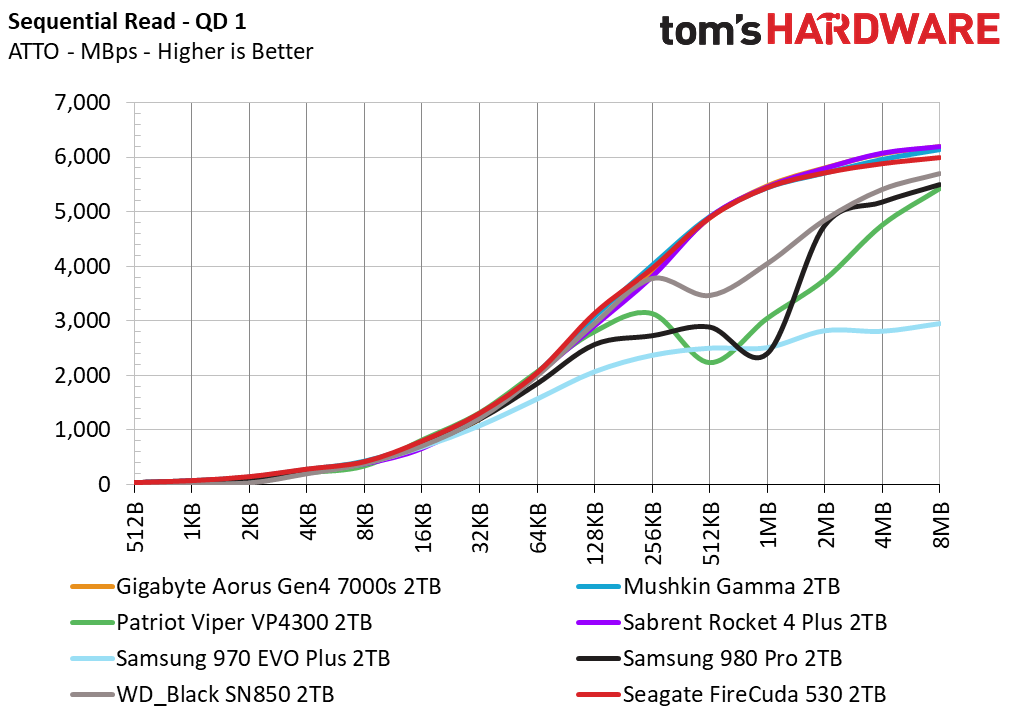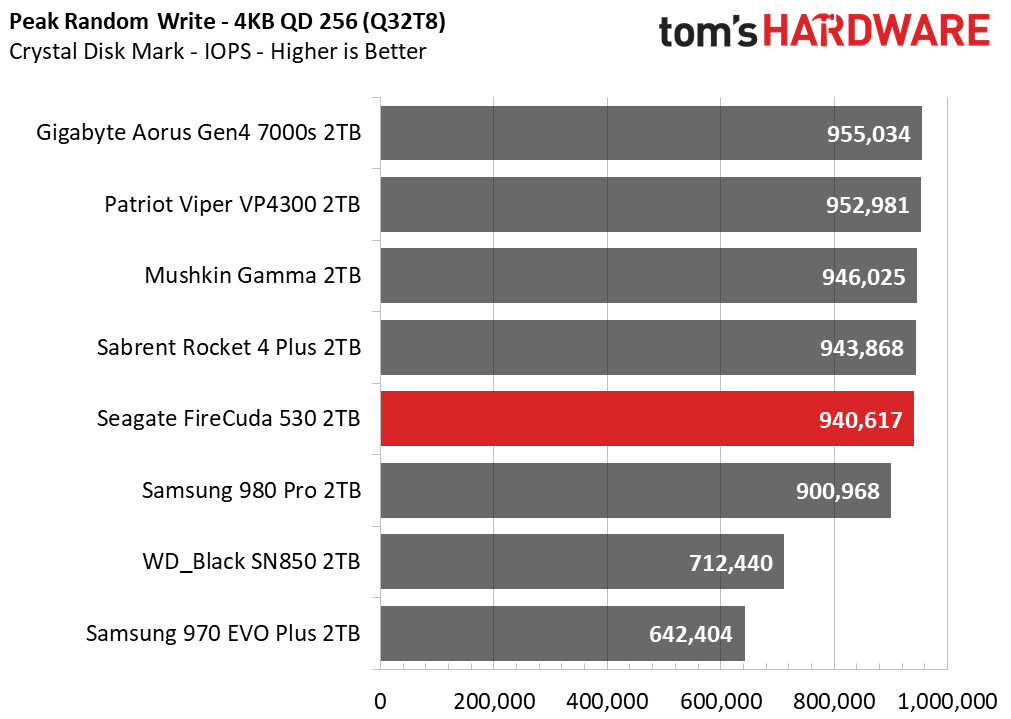Why you can trust Tom's Hardware
Performance Results for Seagate FireCuda 530 2TB
Rating: 4.5 (Editor's Choice)
Verdict: Although it is expensive, thanks to Phison’s PS5018-E18 SSD controller and Micron’s very capable B47R 176L replacement gate TLC NAND flash, Seagate’s 2TB FireCuda 530 is ideal for professionals and enthusiasts who demand fast, reliable, and enduring performance.
FOR
+ Very fast PCIe 4.0 performance
+ Very impressive sustained write speeds and endurance
+ 5-year warranty w/ 3-year rescue data recovery service
+ Cool operation
+ XTS-AES 256-bit encryption
AGAINST
- Expensive
- Less efficient than some competitors
Comparison Products for Seagate FireCuda 530 2TB
Today, we put the FireCuda 530 up against the Best SSDs on the market as well as a few competent E18-based competitors. These include the Samsung 980 Pro, WD Black SN850, Gigabyte Gen4 7000s, Sabrent Rocket 4 Plus, and Mushkin Gamma. We also threw in the Patriot Viper VP4300 and Samsung 970 EVO Plus for good measure.
Get Tom's Hardware's best news and in-depth reviews, straight to your inbox.
Game Scene Loading - Final Fantasy XIV
Final Fantasy XIV Shadowbringers is a free real-world game benchmark that easily and accurately compares game load times without the inaccuracy of using a stopwatch.

Seagate’s FireCuda 530 delivers exceptional game load performance. In this Final Fantasy XIV benchmark, the FireCuda 530 not only managed to outpace both the InnoGrit-based Patriot Viper VP4300 and Samsung’s Elpis-powered phenom, the 980 Pro, but it also dethroned the previous Gen4 champ, having taken first place by just a hair ahead of the WD Black SN850.
Transfer Rates – DiskBench
We use the DiskBench storage benchmarking tool to test file transfer performance with a custom dataset. We copy a 50GB dataset including 31,227 files of various types, like pictures, PDFs, and videos to a new folder and then follow-up with a reading test of a newly-written 6.5GB zip file.


In terms of its large file and folder access performance, the Seagate FireCuda 530 delivered the fastest results we have seen thus far from a retail M.2 SSD. Having scored over 1,600 MBps in the copy round, not even Samsung’s 980 Pro can match its performance. Also, when reading back the .zip file, the FireCuda 530 did so faster than all competitors.
Trace Testing – PCMark 10 Storage Test
PCMark 10 is a trace-based benchmark that uses a wide-ranging set of real-world traces from popular applications and everyday tasks to measure the performance of storage devices. The quick benchmark is more relatable to those who use their PCs for leisure or basic office work, while the full benchmark relates more to power users.






The Seagate FireCuda 530 also delivers exceptional application responsiveness. The FireCuda 530 fills the performance gap between Samsung 980 Pro and WD Black SN850 in both the Quick and Full System Drive benchmarks.
Synthetic Testing - ATTO / CrystalDiskMark
ATTO and CrystalDiskMark (CDM) are free and easy-to-use storage benchmarking tools that SSD vendors commonly use to assign performance specifications to their products. Both of these tools give us insight into how each device handles different file sizes.














In ATTO, the FireCuda 530’s sequential performance ramped steadily across most block sizes, and in CDM, it scored some of the best sequential performance in the group. In terms of random performance, it also delivered very strong results that not only surpassed the WD Black SN850, but also roughly matched the Samsung 980 Pro at QD1. When we ramped up the queue, the FireCuda 530’s random performance scaled well, but didn’t score quite as high in reads as the Samsung 980 Pro or WD Black SN850 at QD 256. However, in reaching roughly 1.6 million random write IOPS, its write performance cannot be touched.
Sustained Write Performance and Cache Recovery
Official write specifications are only part of the performance picture. Most SSDs implement a write cache, which is a fast area of (usually) pseudo-SLC programmed flash that absorbs incoming data. Sustained write speeds can suffer tremendously once the workload spills outside of the cache and into the "native" TLC or QLC flash. We use iometer to hammer the SSD with sequential writes for 15 minutes to measure both the size of the write cache and performance after the cache is saturated. We also monitor cache recovery via multiple idle rounds.





Seagate’s FireCuda 530 utilizes a large SLC cache for writes, and is one of the fastest SSDs to fill. But in our testing, it did not recover the SLC cache within our idle rounds. The cache spans roughly 225GB on our 2TB sample when empty and will write at up to 6.9 GBps until full. Once we filled the cache, its write speed degraded to 3,850 MBps for the majority of the test. And after having written an additional 1.5TB, the FireCuda 530 degraded once again to a final write speed of roughly 1.6 GBps until it was filled.
Power Consumption and Temperature
We use the Quarch HD Programmable Power Module to gain a deeper understanding of power characteristics. Idle power consumption is an important aspect to consider, especially if you're looking for a laptop upgrade. Some SSDs can consume watts of power at idle while better-suited ones sip just milliwatts. Average workload power consumption and max consumption are two other aspects of power consumption, but performance-per-watt is more important. A drive might consume more power during any given workload, but accomplishing a task faster allows the drive to drop into an idle state more quickly, ultimately saving energy.
We also monitor the drive’s temperature via the S.M.A.R.T. data and an IR thermometer to see when (or if) thermal throttling kicks in and how it impacts performance. Bear in mind that results will vary based on the workload and ambient air temperature.




While it consumes more power than the WD Black SN850, the FireCuda 530 scores second amongst the test pool in terms of efficiency under load. Like other E18-based competitors, the FireCuda consumes a lot of power on average and scores some of the highest when looking at peak consumption. However, the FireCuda 530 proves to be the most efficient E18 sample we’ve come across thus far, thanks in part to its use of Micron’s 176L RG TLC flash instead of Micron’s 96L FG TLC.
In terms of thermal sensitivity, the Seagate FireCuda 530 should maintain its cool without throttle under most workloads. At idle, the FireCuda 530’s controller measured 30-35 degrees Celsius in a 24 degrees Celsius environment. After transferring roughly 600GB of data to the SSD, the controller reached a maximum temperature of 75 degrees Celsius, with no performance throttling in sight.
Test Bench and Testing Notes
| CPU | Intel Core i9-11900K |
| Motherboard | ASRock Z590 Taichi |
| Memory | 2x8GB Kingston HyperX Predator DDR4 5333 |
| Graphics | Intel UHD Graphics 750 |
| CPU Cooling | Alphacool Eissturm Hurricane Copper 45 3x140mm |
| Case | Streacom BC1 Open Benchtable |
| Power Supply | Corsair SF750 Platinum |
| OS Storage | WD Black SN850 2TB |
| Operating System | Windows 10 Pro 64-bit 20H2 |
We use a Rocket Lake platform with most background applications such as indexing, windows updates, and anti-virus disabled in the OS to reduce run-to-run variability. Each SSD is prefilled to 50% capacity and tested as a secondary device. Unless noted, we use active cooling for all SSDs.
MORE: Best SSDs
MORE: How We Test HDDs And SSDs
MORE: All SSD Content

Sean is a Contributing Editor at Tom’s Hardware US, covering storage hardware.
-
2Be_or_Not2Be "Rather than operate the flash at 1,600 MTps as we had hoped for and expected, the 530’s flash operates at just 1,200 MTps "Reply
Well, built-in product segmentation already - 1,600 will go with the next Firecuda "540" model, or a 530 "Extreme" one later. -
FastrThnU "Very impressive sstained write speeds and endurance" Come on guys...be professional.Reply -
Alvar "Miles" Udell Question: Why didn't you include the FireCuda 520 as well? TH reviewed the 1TB 520, but since this is the 2TB 530, it's not an apples to apples comparison. Plus the 520 is quite a bit less expensive at $380 vs the 520's $490 for 2TB.Reply -
PapaCrazy More performance than Samsung Pro with twice the endurance and the same 5 year warranty?Reply
Adios Samsung. -
Sleepy_Hollowed ReplyPapaCrazy said:More performance than Samsung Pro with twice the endurance and the same 5 year warranty?
Adios Samsung.
No kidding, and the data recovery is icing on the cake. This is only possible on non encrypted data hence probably why the drive has no hardware encryption.
For a gaming drive or a data crunching drive that doesn’t require encryption, this is the undisputed champion. -
samopa After two (out of eight) Seagate FireCuda 520 2TB fails less than 10 months, I had swear to myself not buy their product again. Yes they replace the broken SSDs because its under warranty, but the lost data on the SSDs are irreplaceable and cost me few contracts and projects, not counting the intangible losses.Reply -
mdd1963 "The FireCuda 530 is a premium device for built professionals..., "Reply
Can those who are in less than optimum shape use them too? :)
